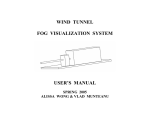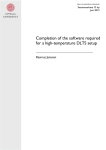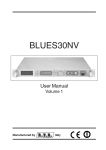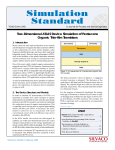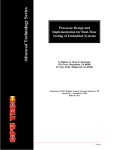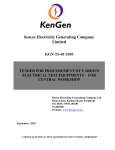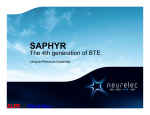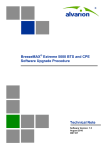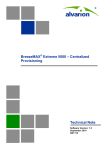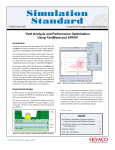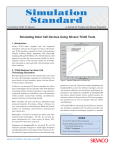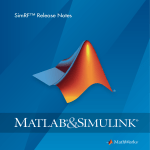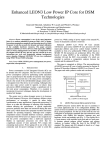Download - Silvaco
Transcript
TCAD Driven CAD A Journal for Process and Device Engineers QUEST: Frequency-Dependent RLCG Extractor Part 1 - Examples of Application Introduction Signals propagated in actual and future IC’s interconnections are spreading, in terms of spectrum frequency, from DC to microwave domain because of the continually increasing clock frequencies of circuits. So, predictions of impedance, delay, rise/fall times and crosstalk levels need to be investigated within this whole spectrum. QUEST is a powerful two-dimensional extractor of the RLCG frequency dependent parameters of the transmission lines. This tool is based on a fast and accurate computation so-called “fictitious domain method” [1]. In this article three examples of its use are presented: ● the variations of mutual/self inductance with the geometrical parameters, ● the crosstalk, ● the skin effect. The reader could compare these results with [2]. 1. The Coupling Effects for Different Geometries The main structure considered in this example consists of two metal wires (_ = 30 MS/m) separated from the substrate by an oxide. The thickness of the oxide and the spacing between the two wires are variables (see Figures 1 and 2). The frequency has been fixed to 10 MHz. Two values have been assigned to each variable, so that QUEST would perform four simulations automatically. Figure 1. Layout definition with parameterized spacing. As outputs QUEST gives the four RLCG matrices. Table 1 summarizes the values of the inductances calculated by QUEST. Continued on page 2.... INSIDE Session Oxide number thickness 1 2 3 4 1 10 1 10 Spacing (µm) Mutual inductance (10-7 H/m) Self inductance (10-7 H/m) Non-Stationary Transport Effects: Impact on Performances of Realistic 50nm MOSFET Technology . . . . . . . . . . . . . . . . . . . . . . . . . 4 8 8 1 1 0.89 2.10 2.92 4.43 5.72 7.27 5.72 7.25 Modeling of Charge Distribution Using SchrodingerPoisson Equations: Application to Double-Gate Transistor (i.e GAA-SOI Transistor) . . . . . . . . . . . . . . . 7 Table 1. Simulated values of inductances from QUEST. Volume 12, Number 2, February 2002 Calendar of Events . . . . . . . . . . . . . . . . . . . . . . . . . . . . . 10 Hints, Tips, and Solutions . . . . . . . . . . . . . . . . . . . . . . . . 11 SILVACO INTERNATIONAL Figure 3 . Schematic diagram of the test circuit used to examine crosstalk between two wires. The further the line from the substrate, the bigger the area of the loop and the higher the self-inductance. The results of the mutual inductance show that the coupling between the two lines increases when the spacing decreases. Thus in VLSI technology, the lines most prone to mutual induction are the lines far from the substrate and close to each other. Figure 2. DOE user-defined variation of pre-defined variables. 2. Crosstalk The self-inductance increases with the oxide thickness, but it is independent of the spacing between the lines. Indeed the self-inductance characterizes the magnetic energy stored in a closed conductor. This conductor is not necessarily physically closed. In our example, a wire and the substrate make a loop. Therefore, giving the following formulas : Neighboring wires are capacitively and inductively coupled to each other, such that a transient signal on a wire can have a significant effect on another unconnected wire: this is the diaphony or crosstalk. The previous example is used with a spacing equal to 1 µm and an oxide thickness equal to 10 µm, so that coupling effects are significant. The simulation is performed at 600 MHz, and the output RLCG matrix is used in SmartSpice for a transient simulation. ϕ = o∫ B.dS ϕ and L=– Ι with B the magnetic field, ➞ ➞ Figure 3 shows the circuit and figure 4 the result of the transient simulation. ϕ the magnetic flux, I the current in the loop whose surface is S. Figure 4. SmartSpice plot of node voltages illustrating crosstalk between two wires. The Simulation Standard Figure 5. SmartSpice plot of node voltages illustarting enhanced crosstalk with reduced rise and fall times. Page 2 February 2002 Figure 6. Two-dimensional plot (left) and one-dimensional plot (right) of current density inside two wires, one excited at 20 MHz. Figure 7. Two-dimensional (left) and one-dimensional (right) plots of current density inside two wires, one being excited at 20 GHz. The skin effect is clearly evident. E with σ=30 MS/m the conductivity of aluminum and E=1V/m the applied electric field, J is the current density in A/cm2. One obtains J= 3000 A/cm2 uniformly in the excited left wire. Figure 7 displays the same wires at 20 GHz, the current density is less than half the previous case and the current density is higher at the edges of the conductor: this is the skin effect. At high frequency, the electromagnetic field is greatly attenuated inside the conductor due to the inductive effect. This explains the skin effect, but also this explains the proximity effect : a current flow appears at the edge of the neighboring conductor. This is what one can observe in Figure 7, in the right hand side wire. The curve v(clk) is the clock signal (a pulse). The wire between nodes 3 and 4 is the aggressor line and the wire between nodes 1 and 2 is the victim line. At the end of the aggressor line (node 4, v(4)), one observes oscillations and voltage overshoot due to the self-inductance. On the victim line, the crosstalk is obvious: a parasitic signal propagates from node 1 (v(1) curve) to node 2 (v(2) curve), despite no bias being applied to the line. It is also well known that the crosstalk increases as the rise/fall times decreases. Figure 5 illustrates this case, the rise time equals to 0.02 ns and the fall time 0.1 ns. The crosstalk is much larger after the ramp-up bias than after the ramp-down of the clock signal. This can be explained by the higher frequency components of the Fourier transform of the clock signal at the rise time than at the fall time. Conclusion This article presented some examples of the electromagnetic behavior of two transmission lines: inductive effects function of geometric variables, crosstalk and skin effect. It shows that QUEST is a powerful tool dedicated to characterizing transmission lines for microelectronic design. QUEST gives a good solution to such analyses that become more and more necessary as the clock frequency and integration increase. 3. The Skin Effect The skin effect can be observed at very high frequencies and large conductors. Indeed the skin depth of aluminum at 1 GHz is 2.8 µm and so very close to the cross-sectional dimensions of a wire. When the skin effect appears the resistance of the line increases because the current flows principally at the edge of the conductor. For the simulation, two wires are defined, spaced by 4 µm, their width is 5 µm, their thickness is 3 µm. Calculations are performed at 20 Mhz and 20 GHz. Figure 6 shows the cross-section of the two wires and a cutline was performed inside them. The current density is displayed at 20 MHz. For this low frequency, the current density value can easily be calculated using : References [1] A Fast and Accurate Computation of Interconnect Capacitance, S. Putot, F. Charlet, P. Witomski, IEDM 1999. [2] High Frequency VLSI Interconnect Modeling, Dennis Sylvester, http://www.device.eecs.berkeley.edu/~dennis/ee241/final.html Part 2 - Comparison with Experiments will be published in the Simulation Standard Volume 12, Number 2, May 2002 issue. J = σ. February 2002 Page 3 The Simulation Standard Non-Stationary Transport Effects: Impact on Performances of Realistic 50nm MOSFET Technology D. Munteanu, G. Le Carval, G. Guegan LETI, CEA / Grenoble, Microelectronics Department 17 rue des Martyrs, 38054 Grenoble, France e-mail: [email protected] Abstract We analyze quantitatively the real impact of technology on the needed level for carrier transport modeling. The results, based on theoretical analyses, are applied to existing devices. This work shows which recipes must be used to evaluate the performances of advanced device architectures (down to 50nm gate length). An original point of this work is the investigation of technology influence (channel doping and LDD doping) on injection velocity at source side and on drain current. The results open the perspective of specific engineering of access regions in order to take full advantage of non-stationary effects on the drain current. 1. Introduction For MOSFETs with gate length ranging around and below 0.1µm, it is now well established that the DriftDiffusion (DD) model fails to predict velocity overshoot and carrier diffusion due to electronic temperature gradients. Moreover, this model neglects the dependence of hot-carrier effects on carrier energy, giving unphysical results for issues related to impact ionization and reliability. Hence, advanced models become mandatory for accurate simulation of nowadays devices, even if the question of the needed accuracy of modeling level for practical applications still remains. Solutions like Monte-Carlo (MC) simulation are very accurate [1], but CPU-consuming, therefore difficult to be applied for technology optimization. For this reason we preferred to use an advanced energy transport model available in commercial tools [2], which combines the advantages of satisfactory accuracy and fast calculations. Figure 1. Influence of energy relaxation time, τrel, on ID(VD) curves (inset: variation of ratio IDsat(EB)/IDsat(DD) with τrel). Consequently we have decided to use devices obtained by simulating the technological process of our 50nm technology [3]. Devices are designed with LDD extensions and pockets, and the oxide thickness is 2.3nm. It was demonstrated that DIBL is a major concern for an accurate analysis of velocity overshoot [4], consequently we optimized the shorter device (Lg=50nm) to have an Ioff lower than 0.1nA/µm. Longer devices have the same structure, which ensures low DIBL. 3. Calibration of Energy Balance Model The simulations were performed with Drift-Diffusion (DD) and a modified Energy Balance (EB) models of ATLAS (Silvaco). The main parameters (mobility, carrier statistics, recombination) are expressed by the same models in EB and DD, with the difference that in EB they are no longer electric field dependent, but carrier energy dependent [2]. Compared to DD, EB considers two additional equations: the conservation of the carrier energy and the energy flux. A critical parameter in EB model is the energy relaxation time, τrel, which governs the magnitude of the non-stationary effects. Figure 1 shows that τrel has a strong impact on terminal currents. The variation of IDsat (drain current at VG=VD=1.5V) versus τrel is linear for τ rel between 0.05ps and 0.5ps, and becomes saturated outside this range (inset in Figure 1). After a short description of the simulated devices, we calibrate the transport model on MC data. Then we analyze how non-stationary effects impact the device behavior and the dependence of this impact on main technological parameters. 2. Simulated Devices Many previous works are performed on simplified devices (constant channel doping, no LDD, no pockets). Since doping profiles strongly influence the spatial variations of electric field, realistic devices are needed for accurate conclusions on non-stationary effects. The Simulation Standard Page 4 February 2002 Figure 2. Profiles of velocity at 10Å channel depth obtained by EB and DD at low and high drain voltage. Figure 3. ID*Lg (VD) characteristics simulated with EB and DD for different channel lengths. When τrel decreases, carrier energy reaches equilibrium with electric field faster, which implies less non-stationary effects. Moreover, for τ rel <0.01ps the DD regime is attained and the EB current is limited to the value predicted by DD model. Since very controversial values of τrel (from 0.1 to 1ps) are given in the literature, we calibrated our simulator on MC data, the best match between EB and MC results being obtained for τrel = 0.2ps. IDsat(EB)/IDsat(DD) ratio is about 1.3 for Lg=50nm and 1.02 for Lg=0.25µm. The practical consequence of this analysis is that we can evidence an inferior limit of the channel length for using the classical DD model. In our case this limit is about 0.25µm, therefore for shorter gate lengths the use of advanced models is necessary for obtaining accurate simulation results. We mention that this limit can also slightly vary as a function of gate-channel and source/drain-channel architecture. Impact ionization is modeled by the Selberherr [2] model in both DD and EB. In EB the effective field depends on the carrier energy, through an energy relaxation length related to τrel [2]. Figure 4 presents the variation of the EB electron velocity along the channel for different Lg. An interesting result is that the velocity overshoot at the drain side increases slowly with Lg, while the opposite behavior was expected. The explanation is that carriers are strongly accelerated in short channels, but they cannot reach the maximum velocity, as they are rapidly collected in the drain. When Lg increases the maximum velocity increases and becomes saturated for Lg=0.2µm. However, this phenomenon is 4. Simulation Results 4.1. Velocity Overshoot The first effect of non-stationary transport in very short channels is the velocity overshoot, which impacts directly the drain current. The electric field-dependence in DD model does not allow to simulate the velocity overshoot phenomenon. This explains the difference between the drain current obtained by EB and DD: (a) at high VD the EB drain current is significantly higher, because in DD model the velocity is limited to the saturation value (about 107 cm/s, Figure 2), leading to under-estimated drain current; (b) at low VD however, the velocity profiles in the channel are almost the same for both models (Figure 2), even in very short channels, which implies the same drain current level. It is worth noting that the difference between currents predicted by EB and DD depends strongly on the channel length, channel doping and LDD region doping. We discuss in the following the impact of each parameter. Channel length. When the channel length increases, the difference between DD and EB decreases as shown in Figure 3, and becomes negligible for L g >0.25µm. February 2002 Figure 4. Profiles of velocity in the channel at 10Å depth for various Lg (VG=VD=1.5V). Page 5 The Simulation Standard Figure 5. Drain and source–end velocity obtained by EB model as a function of the channel length (VD=VG=1.5V). Figure 6. Variation of ratio IDsat(EB)/IDsat(DD) and v(EB)/v(DD) at source and drain end as a function of the gate length (VD=VG=1.5V). not reflected in the drain current because near the drain the increase of the velocity with Lg is accompanied by a strong decrease of the carrier concentration. However, changes in doping imply V T variations, which makes difficult the evaluation of the impact of doping induced-velocity enhancement on ID. A first order decorrelation of the two effects can be obtained by taking into account the ratio I Dsat(EB)/I Dsat(DD). Higher velocity is reflected by a more important increase in the drain current, independent on doping (Table 1). This result opens the perspective of specific engineering of the access regions (LDD, pockets, channel doping) to improve injection velocity, separately of VT adjustments. This type of evaluation only begins to appear in the literature [6]. Moreover, it has been shown that the current enhancement is due to the increase in the velocity at the source side, where the carrier concentration is gate controlled [5]. Indeed, Figure 5 shows that the source velocity increases for shorter channels (because of a higher electric field at the source end), which is reflected by a higher current. The argument of source-side controlled current is also confirmed by the current enhancement in EB compared with DD (Figure 6). At the drain side the ratio between velocity (v) in EB and DD is about 3.5 for Lg=50nm, while the current increases only by 30%. This last value is in good agreement with the ratio between velocities in EB and DD at the source side. The same conclusions are obtained for longer channels (Figure 6). We have also verified the importance of using realistic devices: simulations on simplified structures overestimate the impact of non-stationary effects on the terminal currents. Finally, it is important to note that quantum effects will have to be taken into account for a more accurate analysis of the impact of velocity overshoot on drain current. Channel/LDD doping. For lower channel doping or higher LDD doping, the electric field at the source side increases, which implies a higher velocity (Table 1). Implanted Dose vsource (_107cm/s) IDsat(EB)/IDsat(DD) (x1014cm-2) Channel (LDD dose: 0.8 x1014) 0.1 0.2 0.3 0.97 0.73 0.58 1.34 1.31 1.28 LDD (Channel dose: 3 x1013) 0.5 1 2 0.54 0.78 1.14 1.22 1.33 1.45 Table 1. Impact of channel/LDD doping (L=50nm) on source velocity and drain current. The Simulation Standard Page 6 4.2. Impact Ionization While the classical DD model can be satisfactory for simulating channels longer than 0.25µm, impact ionization needs an energy dependent-model even at much higher lengths. The DD model depends on electric field, which leads to a strong over-estimation of impact ionization for all channel lengths. Continued on page 12... February 2002 Modeling of Charge Distribution Using Schrodinger-Poisson Equations: Application to Double-Gate Transistor (i.e GAA-SOI Transistor). I. Introduction The Gate-All-Around SOI transistor [1], in which the gate oxide and the gate electrode are wrapped around the semiconductor region between the source and drain electrodes, exhibits very attractive features [2,3]. This device has been shown to present excellent Ion/Ioff trade-off, good threshold voltage roll-off reduction and better resisting to short-channel effect and DIBL. In this study, based on the self-consistent solution of Schrodinger and Poisson equations, we attempt to show that the maximum of electrons concentration can be located in the middle of the semiconductor film and that it exist an "optimal" thickness of the Si-film. This is a major divergence with classical models which predict always the maximum of electron concentration at the semiconductor interface and that the reduction of the film thickness is always better against parasitic effects. II. Device Structure Figure 1. GAA-SOI device structure. The GAA-SOI was built in ATLAS. In this work symmetrical gate-SiO2-Si(p)-SiO2-gate structure with uniformly doped substrate is considered (Figure 1). The main characteristics are: fixed gate oxide thickness of 25nm, variable Silicon film thickness from 1.5nm to 20nm and uniform p-type doping of 1e18 cm-3. III. Schrodinger Calculation in ATLAS The self-consistent Schrodinger-Poisson model is enabled by setting the SCHRO parameter of the model statement. With this parameter set ATLAS solves the one dimensional Schrodinger’s equation along a series of slices in the y direction relative to the device. Each slice is taken along an existing set of y nodes in the ATLAS device mesh. After the Schrodinger’s equation solution is taken, carrier concentration calculated from Schrodinger’s equation are substituted into the charge part of the Poisson’s equation. The potential derived from solution of Poisson’s equation is substituted back to Schrodinger’s equation. This solution process (alternating between Schrodinger’s and Poisson’s equation) is continued until convergence is reached and a self-consistent solution of Schrodinger’s and Poisson’s equation is obtained. For more details see [4]. IV. Results and Discussion Figure 2. Spacial distribution of electrons concentration using "classical" or Schrodinger" calculation. February 2002 Page 7 Figure 2 presents spatial distributions of electrons concentration. The fundamental difference between the classical and Schrodinger calculation lies in the fact that the maximun of electrons concentration is localized at the semiconductor interface for classical calculation whereas it is localized inside the semiconductor film using Schrodinger-Poisson calculation. The Simulation Standard Figure 3. Conduction Band and discrete Energy Levels in the semiconductor film. Figure 4. Conduction Band and discrete Energy Levels in the semiconductor film. Note the two subwells for the lowest Energy Level E1. Moreover, the quantization of electron energy in the double gate SOI structure depends on the film thickness. At very thin semiconductor films, the energy quantization results mainly from the confinement of electrons in the semicondcutor. Then the discrete energy level can be expressed by the rectangular well approximation. To be able to simulate these effects, the 2D Electron Gaz has to be described by the self-consistent resolution of Schrodinger and Poisson equations. For the reason explained abve, one interesting point is that if the semiconductor film is thin enough, the maximum of electron concentration can be located in the middle of it (Figure 5), supporting the concept of volume inversion [2]. Again the classical theory gives the electron concentration always maximum at the semiconductor surface. At larger semiconductor film thickness two additional potential subwells are created at both surfaces which can confined the lowest electron states E1 (Figure 4). On top of that, one can observed that the maximum charge density increases and then decreases as a function of Tsi [5]. Figure 6 and 7 illustrate and explain this aspect. In Figure 6 it is sown that for the thinnest thicknesses, the charge appears to be mainly controlled by the lowest Energy level. Indeed Energy Levels below the Fermi Level are full of electrons whereas Energy Levels above the Fermi Level are empty. E2 in Figure 6 for Tsi=1.5nm is located above the Fermi level and thus empty of electrons. However, due to the confiment, the distance between the first Energy level and the Fermi level increases when the film thickness decreases, which conducts to a decrease of the charge for a film thickness below 5nm (Figure 7). We have quantify the total number of electrons in the channel using one of the powerful features of the extract routine available in deckbuild. The key word to use to do that in the EXTRACT statement is 2D.AREA, F i g u r e 5 . I n f l u e n c e o f S i l i c o n f i l m t h i c k n e s s o n e l e c t r o n which allow to perfrom double integral of any concentration distribution. quantities present in the structure file. Refer to [6] for The Simulation Standard Page 8 February 2002 V. CONCLUSION As a conclusion we have demonstrated in this article the importance of the use of SchrodingerPoisson calculation to evaluate performance of novel devices like Double Gate Transistor (i.e GAA-SOI Transistor) where the dimension (Si film thickness) are very small and thus leads to confinement and quantization. Based on this study we have shown that the optimization of performance of such devices will not be achieved by only reducing the thickness of the film (as predicted by the classical approach) but that it exist on optimum of Si-film thickness that can potentially conduct to better performance. References [1] J.P. Colinge et al. IEDM (1990) p. 595 [2] F. Balestra et al. IEEE Electron Device Lett. 8, 410 (1987) [3] B. Majkusiak et al. IEEE Trans. Electron Devices 45, 1127 (1998) [4] “ATLAS User’s Manual- Vol 1” p. 3-85 Figure 6. Discrete energy Levels(E1 ‡ E3) as a function of Si film thickness. [5] S.Monfray et al. ESSDERC (2000) p. 336 [6] “Interactive Tools User’s Manual”- Vol 1 p. 5-16 more details. We show that it exists an "optimal" Si-film thickness (Figure 7), for which the total number of electrons is maximum. For Na=1e18 this is verified for Tsi=3.5nm. As a consequence this result has a direct impact on the design of GAASOI Transistor or more generally Double Gate Transistor since it has been demonstrated that it exist an optimized film thickness leading to a maximum of electrons concentration. The idea that consist of reducing the film thickness to obtain better performance seems no more valid in this case. We have investigated the influence of doping of the Si-Film and it appears that the "optimized" thickness increases when the doping level in the film decreases (Figure 9). Indeed an "optimized" film thickness is around 7nm for Na=1e17. Figure 7. First Discrete Energy Levels in the semiconductor film as a function of Si film thickness. February 2002 Page 9 The Simulation Standard Calendar of Events February 1 TCAD W/S- Scottsdale, AZ EDS Techno Fair-Yokohama ASP DAC - Yokohama,Japan 2 EDS Techno Fair-Yokohama ASP DAC - Yokohama,Japan 3 4 5 6 7 8 9 10 11 12 13 Int’l Conf. on Microelectronics and Interface - Santa Clara, CA 14 Int’l Conf. on Microelectronics and Interface - Santa Clara, CA 15 Expert W/S - Scottsdale, AZ 16 17 18 19 20 21 TCAD W/S - Chelmsford, MA Int’l Forum On Semicon Tech Yokohama - Japan 22 Int’l Forum On Semicon Tech Yokohama - Japan 23 24 25 Compound Semiconductor Outlook - San Mateo, CA 26 Compound Semiconductor Outlook - San Mateo, CA 27 Compound Semiconductor Outlook - San Mateo, CA 28 March 1 2 3 4 5 6 Bulletin Board CLEVER W/S - Scottsdale, AZ DATE - Paris, France DATE - Paris, France TCAD W/S-Cambridge University DATE - Paris, France 7 DATE - Paris, France 8 DATE - Paris, France 9 10 11 GOMAC - Monterey, CA 12 TCAD /CAD W/S- Fairfax, VA TCAD W/S-Cambridge University GOMAC - Monterey, CA 13 GOMAC - Monterey, CA 14 GOMAC - Monterey, CA 15 ATLAS W/S - Scottsdale, AZ 16 17 18 19 20 Int’l Conf. for Microelectronic Test Structures - Cork, Ireland 21 Int’l Conf. for Microelectronic Test Structures - Cork, Ireland 22 Int’l Conf. for Microelectronic Test Structures - Cork, Ireland 23 24 25 26 27 28 Japan Applied Physics Aoyama Gakuin University 29 Japan Applied Physics Aoyama Gakuin University 30 Japan Applied Physics Aoyama Gakuin University 31 Japan Applied Physics Aoyama Gakuin University Silvaco Wins Judgement Against Avant! Again In July 2001 the Appeals Court remanded a 1997 judgement of $31.4 million to the Superior Court to fix a number of small mistakes. The crown jewel of the original 1997 judgement, the $20 million default award, was preserved intact. The prove-up hearing for this default was held February 6th, 2002 before Superior Court Judge Jack Komar. After hearing the evidence Judge Komar awarded Silvaco the $20 million default judgement (plus $6.148 million in interest.) TCAD Simulation Workshops Silvaco is delighted to announce a workshop program at Cambridge University. The one-day workshop is intended for users of Silvaco's TCAD Process and Device Simulation software suite. It will be hosted at Cambridge University on the March 6, 2002 and repeated on March 12, 2002. The workshop is free of charge to customers taking advantage of our support package. For more info contact: [email protected] Silvaco Signs Everest as New Digital Partner Everest Design Solutions, LLC today announced a partnership with Silvaco International as it’s exclusive EDA tools distributor. Silvaco is both pleased and eager to begin selling the complete Everest line to customers seeking quality digital solutions. This partnership will allow Everest to draw on Silvaco’s established global presence while providing Silvaco with a strong entry into the digital design space of the EDA market. For more information on Everest Design Solutions visit our web site at: www.best.com/~eds. If you would like more information or to register for one of our our workshops, please check our web site at http://www.silvaco.com The Simulation Standard, circulation 18,000 Vol. 12, No. 2, February 2002 is copyrighted by Silvaco International. If you, or someone you know wants a subscription to this free publication, please call (408) 567-1000 (USA), (44) (1483) 401-800 (UK), (81)(45) 820-3000 (Japan), or your nearest Silvaco distributor. Simulation Standard, TCAD Driven CAD, Virtual Wafer Fab, Analog Alliance, Legacy, ATHENA, ATLAS, MERCURY, VICTORY, VYPER, ANALOG EXPRESS, RESILIENCE, DISCOVERY, CELEBRITY, Manufacturing Tools, Automation Tools, Interactive Tools, TonyPlot, TonyPlot3D, DeckBuild, DevEdit, DevEdit3D, Interpreter, ATHENA Interpreter, ATLAS Interpreter, Circuit Optimizer, MaskViews, PSTATS, SSuprem3, SSuprem4, Elite, Optolith, Flash, Silicides, MC Depo/Etch, MC Implant, S-Pisces, Blaze/Blaze3D, Device3D, TFT2D/3D, Ferro, SiGe, SiC, Laser, VCSELS, Quantum2D/3D, Luminous2D/3D, Giga2D/3D, MixedMode2D/3D, FastBlaze, FastLargeSignal, FastMixedMode, FastGiga, FastNoise, Mocasim, Spirt, Beacon, Frontier, Clarity, Zenith, Vision, Radiant, TwinSim, , UTMOST, UTMOST II, UTMOST III, UTMOST IV, PROMOST, SPAYN, UTMOST IV Measure, UTMOST IV Fit, UTMOST IV Spice Modeling, SmartStats, SDDL, SmartSpice, FastSpice, Twister, Blast, MixSim, SmartLib, TestChip, Promost-Rel, RelStats, RelLib, Harm, Ranger, Ranger3D Nomad, QUEST, EXACT, CLEVER, STELLAR, HIPEX-net, HIPEX-r, HIPEX-c, HIPEX-rc, HIPEX-crc, EM, Power, IR, SI, Timing, SN, Clock, Scholar, Expert, Savage, Scout, Dragon, Maverick, Guardian, Envoy, LISA, ExpertViews and SFLM are trademarks of Silvaco International. The Simulation Standard Page 10 February 2002 Hints, Tips and Solutions William French, Applications and Support Manager Q. How do I install and use my Silvaco TCAD tools on a Windows 2000 machine ? Q. After installing the tools in the prescribed manner how do I know if I was successful ? A. Silvaco software supports licensing on Windows NT (Serverice Pack 4. or later) and Windows 2000 Pro. As a new user you should receive 3 components before you can begin to run the software. A. Bring up the system Task Manager (Ctrl-Alt-Del and then choose Task Manager), show all processes that are running and look for one called rpc.sflmserverd that should be running. If this is not in the list, perform the operation: ● ● ● the Silvaco software itself a security key (also called a dongle) a license file (sent via email from Silvaco HQ) All three of these are necessary before you can run the software. NOTE: Silvaco license server requires the existence of the folder c:\Temp in order to store temporary files. If this folder does not exist the software will not work. Step 1. Insert the dongle into either the parallel port or the USB port. Both are supported by Silvaco, but are different keys. The one you receive is decided at time of purchasing the software. Start-->Programs-->Silvaco--Sflm-->Start Server Note: If Start Server option is not there then you failed to click the License option suggested in Step 2. Remove the installation and repeat. Q. How do I know what licenses are available or who has checked out licenses ? A. The installation creates a Shortcuts folder on the PC Desktop. Double-clicking on this icon will cause a pop-up to appear with the application Shortcuts. Two of these are labelled "Server status" and "Current users". If the user double-clicks on these icons a DOS window should appear that shows all available licenses and which users have checked out particular licenses, respectively. Step 2. Install the software from either the CDROM or the FTP downloaded file. This is started by executing the Setup utility. Normal installations should follow the defaulted choice for each window. This will be either Next or Yes. Note: When choosing products to install make sure that the LICENSING option has been checked. Q. I have obtained a new license file what should I do ? A. To activate the new license file, simply copy it to the folder c:\Silvaco\etc where the software was installed. Then rename this file to simply "license" and reboot the PC. Note: Make sure that there is no extension on the file. If the file is called for instance license.dat then the license manager will not start. Step 3. During the software installation you will be asked to navigate to the license file that you received from Silvaco. Make sure this is available on your machine. Step 4. Restarting the Windows operating system is necessary in order to enable communication between the software and the dongle. This is normally recommended. February 2002 Q. I have been running the software successfully, but suddenly nothing will work. What should I do ? A. A number of different actions may have caused this to occur. Below are some common reasons. ● Page 11 the license file has expired. Certain Silvaco licenses are for a fixed duration. Open the license file inside Wordpad and look for the lines entitled END_DATE. If any exist that are past then your license has expired and you should contact your Silvaco representative or email [email protected] with a copy of your license file. The Simulation Standard ● ● the date or time on the machine may have been modified. If the system clock is more than one hour out of sync with local time, correct the machine time, delete the folder c:\Temp\.sflm and reboot the PC Q. Is there any documetation available to help in troubleshooting installation problems ? A. After the software is installed, the user can find an extensive list of troubleshooting tips in the file entitled FAQ which resides in the Shortcuts folder as well as in c:\Silvaco\var\FAQ.txt the dongle may have been damaged. To check this run the following command from the DOS prompt c:\Silvaco\bin\showid.exe -time the output from this should be self explanatory. This will also display the machine name and HASP number. The machine name should be repeated in the file c:\Silvaco\var\sflmserver and the HASP number should be the same as the line in the license file that starts with LM_HOSTIDS. Call for Questions If you have hints, tips, solutions or questions to contribute, please contact our Applications and Support Department Phone: (408) 567-1000 Fax: (408) 496-6080 e-mail: [email protected] Hints, Tips and Solutions Archive Check our our Web Page to see more details of this example plus an archive of previous Hints, Tips, and Solutions www.silvaco.com If these are not sufficient to correct the problem contact [email protected]. ...continued from page 6 Figure 7 presents ID(VD) curves for short and long channels, illustrating the over-estimation of the avalanche region by the DD model. Therefore EB model must be used for impact ionization at all channel lengths. Accurate simulation of impact ionization is a very important issue for simulating substrate current and hot carrier effects in bulk devices. This is also a critical point for reproducing accurate I D(V D) curves and kink region in partially depleted SOI devices [7]. 5. Conclusion In this paper we have presented the impact of the modeling level on the electrical behavior of 50nm bulk MOSFET technology. For accurate conclusions, realistic devices have been considered in simulation. The current enhancement due to non-stationary effects must always be referred to the velocity at the source side of the device, and not to drain side. For reproducing the impact of velocity overshoot advanced models are necessary for channel lengths below 0.25µm, while for impact ionization an energy dependent model must be considered even for much higher dimensions. An original analysis in this work is the quantitative evaluation of technological parameters impact on injection velocity and drain current. The results show that for taking full advantage of non-stationary effects on device performances specific engineering of access regions have to be envisaged. The Simulation Standard Figure 7. ID(VD) curves obtained by EB and DD with impact ionization model at different Lg. 6. References [1]. M. Fischetti, S. Laux, Phys. Rev.B, no.14, p.9721, 1988. [2]. “ATLAS Users Manual”, Silvaco. [3]. C. Caillat et al., 1999 VLSI Tech. Dig., p. 89-90. [4]. C. Jungeman et al., Proceedings ESSDERC 1999, p. 236. [5]. G. Baccarani et al., Solid State Electronics, vol. 28, no.4, p. 407, 1985. [6]. S. Odanaka, A. Hiroki, IEEE Trans. on Electron Dev., vol. 44, no. 4, p. 595, 1997. [7]. D. Munteanu et al., Proceedings of International SOI Conference, p. 58-59, 2000. Page 12 February 2002 Your Investment in Silvaco is SOLID as a Rock!! While others faltered, Silvaco stood SOLID for 15 years. Silvaco is NOT for sale and will remain fiercely independent. Don’t lose sleep, as your investment and partnership with Silvaco will only grow. SILVACO CONTACTS: I N T E R N AT I O N A L Silvaco Japan [email protected] USA HEADQUARTERS Silvaco Korea [email protected] Silvaco International 4701 Patrick Henry Drive Building 2 Santa Clara, CA 95054 USA Phone: Fax: 408-567-1000 408-496-6080 [email protected] www.silvaco.com Silvaco Taiwan [email protected] Silvaco Singapore [email protected] Silvaco UK [email protected] Silvaco France [email protected] Silvaco Germany [email protected] Products Licensed through Silvaco or e*ECAD Ve n d o r P a r t n e r














